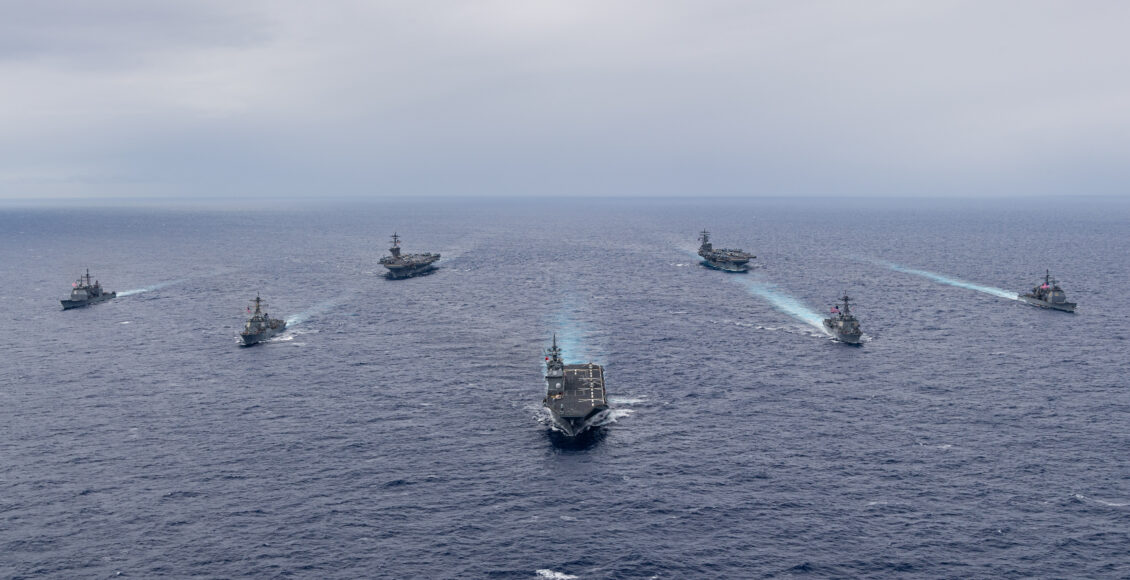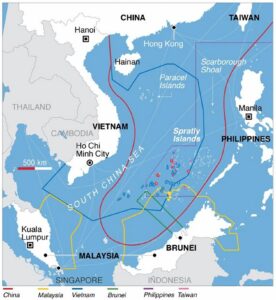Navigating Troubled Waters: The Sino-Filipino Maritime Dispute

On October 23, 2023, tensions in the South China Sea escalated as a Chinese Coast Guard ship collided with a Filipino vessel in a disputed area. China’s expansion into the South China Sea started decades ago, and has grown considerably during the past five years. This incident, resulting from Chinese expansion, is a telling example of ongoing disputes over which state has jurisdiction over contested maritime areas. Both China and the Philippines claim sovereignty over the precise zone of the clash. While Manila summoned China’s ambassador to the Philippines and filed a diplomatic protest against Beijing, China accused the Filipino vessel of trespassing in what they decided were Chinese waters.
The specific area, near Second Thomas Shoal, lies within the Philippines’ Exclusive Economic Zone according to the United Nations Convention of the Law of the Sea (UNCLOS). Enacted in 1973 and signed by China in 1996, the treaty outlines the portion of sea or ocean being owned by each state. The UNCLOS has been violated multiple times by China. The most significant infringement involves China asserting indisputable sovereignty over a large portion of the aforementioned sea, such that the Exclusive Economic Zone claimed by China overlaps with the zones of Vietnam, Malaysia, and the Philippines. China, being the regional power, claims 80 per cent of the South China Sea and engages in activities such as mining, fishing, and island construction programs in areas that technically belonging to other states. In 2016, China was condemned by the Permanent Court of Arbitration for breaching the sovereign rights of the Philippines. But despite the 2016 ruling, the lack of established enforcement mechanisms has left the judgement largely symbolic.

The context of the October 2023 collision is complex, as Filipino boats were heading to a military outpost that had been under a Chinese blockade. This factor has sparked fears that the collision could fuel a larger conflict in the area, and that a military escalation in the region could threaten international security. The Chinese government has recently emphasised the strategic significance of maritime power, a stance reinforced by its status as the world’s leading shipbuilder. This dynamic, combined with the fact that China takes claim over most of the South China Sea, demonstrates China’s potential unwillingness to back down from issues related to maritime sovereignty.
In the 1950s, the Chinese government established 5 principles of peaceful coexistence which are meant to inform China’s foreign policy. These principles guaranteed that China would respect the sovereignty of neighbouring states, practice non-aggression, and ensure equality among states. However, China’s assertive actions in the South China Sea starkly contradict the principles it once championed. The great power took advantage of its position in recent years by infringing on neighbouring maritime areas, ultimately increasing its regional power. The sovereignty of smaller states such as Malaysia, Vietnam, and Brunei are directly threatened by such aggressive behaviour from the powerful neighbour. The Philippines are no exception, as they face the challenge of defending their maritime rights with limited naval strength and patrol capabilities. Weaker states bordering the South China Sea also suffer from limited geopolitical and diplomatic influence, as their capacity to enforce their claims and engage in negotiations is overshadowed by China’s dominance.
The Chinese presence in the South China Sea increases the risk of a military escalation in the region. After the boat clash, the United States warned China that it would defend the Philippines in case of an armed attack in the area. The United States has numerous allies in the region, including the Philippines, which ratified the Mutual Defense Treaty along with the United States in 1951. Accordingly, there is a wide American presence in the South China Sea, and the United States has since fully militarised islands in the area by equipping them with anti-ship and anti-aircraft missile systems.
The United States is an important presence in the region; it aims to maintain freedom of navigation and regional stability, and is viewed by China as a threat to its interests. The American positioning ultimately damages mutual confidence between leaders in Beijing and Washington, and raises the possibility of military tensions and conflicts. Minor conflicts like the Sino-Filipino boat collision may exacerbate the complex security context, in which the actions of both parties can be misinterpreted and lead to a larger conflict. In this regard, international laws are not very successful in mitigating such conflicts since China demonstrates a disregard for maritime legislation, which in turn imposes no real penalties on the Chinese government.

The Sino-Filipino collision in October 2023 is only one example of perceived Chinese aggression in the South China Sea. For instance, in June 2019, China sank a Filipino fishing boat in the waters. These aggressions are not just targeted at the Philippines. In March 2023, a Vietnamese vessel almost got hit by a Chinese coast guard ship. 2023 has seen a historical number of incidents in the South China Sea, and these minor conflicts are more frequent and severe compared to previous years. Coupled with a tense geopolitical context in which the world order is already threatened by Russia’s invasion of Ukraine, a major violation of state sovereignty in the South China Sea would only put pressure on the international system and exacerbate global conflict.
Edited by Clare Rowbotham.
Featured Image: “231107-N-ER894-1122” by U.S. Pacific Fleet is licensed under CC BY-NC 2.0 DEED.
